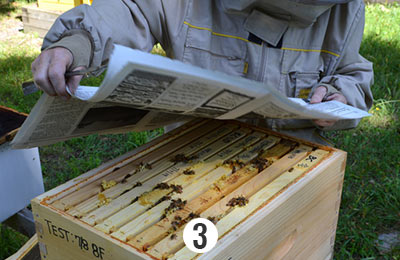Sooner or later it happens: you have two colonies that you want to combine into one. But every beekeeper knows that bees are fiercely attached to – and very protective of – only their own, home colony.
The flip side of learning how to make splits is learning how to combine two colonies into one. Fortunately, compared to the many, sometimes complicated, ways of making splits, doing the opposite thing – combining – is extremely easy to do.
The first issue to consider is the most important one every time you are thinking of combining two colonies: Why are one, or both, colonies weak enough that combining seems like a good idea. A colony that's small or weak because it has disease or parasite problems will just turn those problems into a new, bigger problem. Fix those issues, if they exist, first, before uniting the two colonies.
Why would you want to combine two colonies?
One of the most common reasons for doing a combine is when a colony has lost its queen or a virgin queen fails to return from her mating flight, leaving the colony hopelessly queenless. If it’s early enough in the season, you can provide the colony with another chance to make their own queen, but often it’s past mid-summer when you finally give up. By September, it’s too late to expect a colony that has experienced an extended period of broodlessness to be able to reverse course and build up before winter. These colonies may be excellent candidates to be combined with a queenright colony, boosting it with both bees and resources.
Another common reason to want to combine two colonies is when you have two smaller colonies, "dinks" as they are often called. As long as their "dinkiness" isn’t caused by untreated parasites or diseases, these are also good candidates for combining into a single colony. That will increase their chances for survival and keep your equipment full of strong hives that will allow early re-splitting next spring. (This is a strategy often described as "taking your winter hive count losses in the fall.")
The only hitch in the combine-two-colonies scenario is when you have two queenright colonies, and you need to wind up with only one queen. Some beekeepers just do the combine anyway and let the bees (the queens, actually) sort it out. But this can result in unnecessary colony stress. And almost certainly, the queens will fight with each other to determine which one will conquer the other. Sometimes that can result in injuries, or even death to both of them, leaving the colony queenless in the end.
Since this is not a manipulation that would happen in nature, but only at the beekeeper’s instigation, it’s better for the beekeeper to manage the queen selection by preemptively removing one of the queens before doing the combine. Sometimes the choice of which one to keep is easy, but at other times you must think about it. In general, younger queens are preferred to older ones. (After all, some beekeepers routinely replace their queens on an annual basis, no matter what.) However, age is not the only factor: an older queen who is producing an excellent brood pattern would be preferable to a feckless younger one.
With the queen issue settled by culling the less-desirable queen (if needed), the newspaper combine proceeds exactly as if you had only one queen among the two colonies.




